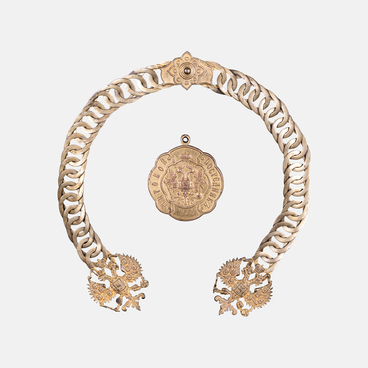The museum’s collection contains a personal badge of the Volinsky Lifeguard Regiment for participation in the February Revolution. It is a silver-plated wreath of wheat ears and a palm branch. A soldier with the regimental banner in his right hand is in the center of the badge, against the banner covered in red enamel. To his left is a symbolic image of Freedom, represented by a female figure with a laurel branch in her left hand, leaning on a shield with the inscription “February 27. 1917”. The ribbon below is engraved with the inscription “A. Safronov. Volynets”.
A native of the Simbirsk Governorate, Agafon Safronov was drafted into the Russian Imperial Army during the First World War. He served as a private in the reserve battalion of the Volinsky Lifeguard Regiment, which was considered one of the most disciplined and reliable regiments. The regiment took part in hostilities against the German army. On February 27, 1917, the 1st company of the Volinsky Regiment refused to open fire and disperse the demonstrators in Petrograd. Senior non-commissioned officer Kirpichnikov led the soldiers against the company commander, Captain Lashkevich. The officer who tried to reason with his subordinates was immediately killed. Later, the rebels, led by revolutionary leaders, were joined by soldiers from the 4th company, soldiers of the reserve battalions of the Preobrazhensky Lifeguard Regiment, workers and even passers-by. Subsequently, the regiment quickly joined the Bolsheviks.
During the Kornilov putsch (late August of 1917), the regiment demanded the establishment of a homogeneous socialist government and the release of the Bolsheviks arrested for their responsibility for the July Days. On October 18, 1917, the regiment decided to support the armed uprising. During the October Revolution, the Volinsky Lifeguard Regiment took part in the storming of the Winter Palace, guarded the approaches to Smolny, and occupied the Finland Station. During the Kerensky-Krasnov offensive on Petrograd, Tsarskoye Selo was occupied. On December 14, they took part in the nationalization of the Petrograd Bank.
The badge of the Volinsky regiment was the last regimental badge issued to soldiers who were the first to join the revolutionaries in 1917. At the same time, the soldiers of the reserve battalion of the Volinsky regiment, who directly participated in the February events, received the badges at the expense of the regimental treasury. The badge came with the engraved surname of the recipient. At the same time, the soldiers of the same regiment, who were at the front, had the badge made at their own expense which did not feature surnames.


